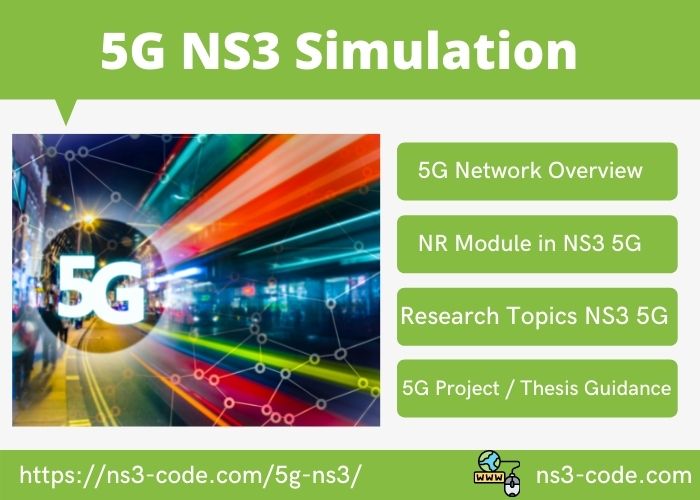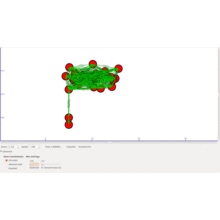Ultimate Guide : 5G NS3 Network Simulation
5G NS3 networks are the promising mobile network to give assurance of faster communication. In this service, the large-scale geographical space is split up into numerous small units called cells. These cells are linked up with one another through radio waves and resource-constrained antennas for data sharing between sender and receiver.
5G Network Overview
Get to know about 5G NS3 Projects in detail here.5G enables transmission of the signals through different frequency bands allocated by the transceiver. Also, these colossal collections of frequencies are re-claimed in other cells at the time of execution. Here, the local antennas are linked with the transmission electronics in the cellular network, and routers are connected with wireless backhaul links or fiber optic cables for smooth internet service. As mentioned earlier, the 5G network area is split up into numerous different cells. In this, each cell type has unique characteristics to perform. For your information, here we have given you the different cell types of 5G network for 5G New Radio (NR) FR2.
Characteristics of 5G Network
- Cell Type -Micro cell
- Highest number of users – 128 to 256
- Development environ – Urban areas to fill coverage gaps
- Longest distance from the base station – few hundreds of meters
- Output power (mW) – Outdoors: ranges from 5000 to 10000
- Cell Type –Femtocell
- The highest number of users – Industries: 16 to 32 and Personal: 4 to 8
- Development environ – Industries and Personal
- Longest distance from base station: tens of meters
- Output power (mW) – Outdoors: ranges from 200 to 1000 and Indoors: ranges from 100 to 250
- Cell Type -Metro cell
- The highest number of users – > 250
- Development environ – Urban areas to provide additional capacity
- Longest distance from the base station – hundreds of meters
- Output power (mW) – Outdoors: ranges from 10000 to 20000
- Cell Type -Pico cell
- The highest number of users: 64 to 128
- Development environ – public areas like shopping malls, airports, train stations, skyscrapers
- Longest distance from the base station – tens of meters
- Output power (mW) – Outdoors: ranges from 1000 to 5000 and Indoors: ranges from 100 to 250
Next, we can see the real-time applications of 5G NS3 networks. Generally, 5G has already left its footprints in several research areas like WSN, IoT, Cloud Computing projects, Artificial Intelligence, etc. For your awareness, we have specified the most popular applications in wireless 5G communication.

5G Network Applications
- Public safety
- The next-generation of 5G based public security is moving towards Mission-critical communication (MCPTT) for improving the data privacy
- Automobiles
- The current 5G Autonomous vehicles are motivated in the direction of the cellular-V2X network field, which uses 3GPP standard.
- Also, it is designed to launch the data sharing among vehicle-to-vehicle (V2V) and vehicle-to-infrastructure (V2I)
- Wireless Multimedia broadcast
- In the recent broadcast camcorders, Serial Digital Interface (SDI) cables are highly replaced with wireless 5G connection to transmit the encrypted data.
- Fixed wireless
- Though fixed broadband is fast data communication, it is subjected to a fixed location. Also, it uses direct dedicated links using fiber optic, DOCSIS, VDSL, and more.
- Now, fixed broadband technology is gradually getting replaced by fixed-wireless connections like radio waves, electromagnetic waves, etc.
What is meant by NS3 in a 5G network?
NS3 is a very useful open-source platform for simulating all sorts of 5G wireless system architecture. At the beginning stage, it uses non-standalone architecture with LTE features. Now, it is updated to utilize the Fronthaul and non-standalone LTE access along with 3GPP standards for efficient radio access segmentations.
In the fast-growing digital world, the majority of the wireless technologies are holding their hands with 5G networks due to their capabilities of high performance, capacity, and interoperability of integrating other systems. This creates revolutionary growth in 5G NS3 networks research. To a great extent, it can also be incorporated with any wireless network communications.
For instance: In the internet of the things research field, we can employ 5G networks in any of the following areas
- Vehicle-to-Vehicle (V2V) communication
- Device-to-Device (D2D) communication
- Machine-to-Machine (M2M) communication
In addition, it also supports heterogeneous networks (HetNet) communication for smart transport applications and services. In this, it works effectively in any sort of system architecture at any network densification. Next, we can see other add-on technologies that support seamlessly in 5G networks.
Key Enabling Technologies in 5G Network
- 5G Experiments Analysis for Public Safety
- Physical Layer Key Generation
- IoT Cross-Vertical and Horizontal Applications
- 5G Basic Functionalities
- Real-time Network Softwarization and Control
- New Design of Microelectronics Components
- Next-Generation Satellite and Optical Communication
- Vision and Future Technologies of 5G and Beyond 5G
- Integration of Radio Access with Software-Defined Networks
New Radio Module in NS3 for 5G Network
Next, we can see about the New Radio (NR) module, which is newly introduced in the NS3 simulation tool as a pluggable module. LENA is the open-source LTE/EPC network platform with the capability of an extended mmWave module. And, it includes the features of basic PHY and Mac layer protocols with improved protocols and techniques such as 3GPP, TDD, beamforming, and many more. Further, it is able to plug with NS-3-Dev 3.31 version and above.
Below, we have mentioned some interesting features of the NS3 in the NR module.
- Include Helpers to manage the frequency bands at different scenarios. For instance: Multi-Cell Configurations helpers are used to multiple cells at various alignments. Radio Environment Map (REM) helpers are used to make UL and DL maps.
- Capable of designing and simulating Spatial Channel Model (SCM) in the spectrum between 0.5 and 100 GHz
- Allow various Bandwidth Part (BWP) and component carrier adaption through BWP managers.
- With respect to Modulation and Coding Scheme tables and Low-Density Parity-Check nodes, it supports the physical layer in the new radio. Through this, we can perform code block segmentation (LDPC- NR) and graph selection (DL-SCH-LDPC)
- Works at different NR-scheduling timings such as N0, K0, N2, K2, N1, and K1
- Enable scalable NR frame auto-configuration based on various multi-numerologies
- Support Non-Standalone Architecture (NSA)
- 4G Evolved Packet Core (EPC)
- 5G Radio Access Network (RAN)
- Allow tracking the single beam at changing time periods using different multiple access techniques such as OFDMA and TDMA
- Easy to modify the structure of the MAC layer protocol with their scheduler. Also, for both OFDMA and TDMA techniques, it concurrently considers time and frequency features.
- Support both TDD and FDD Duplex modes with TDD configuration of UL/DL patterns
- It is provisioned with an NR-U extension for working with unlicensed frequency bands. For that, it uses LBT based switching technique in multiple channel access.
- Along with scheduling requests and 3GPP, it supports grant-free uplink transmission Uplink (UL) for low latency services.
In general, our developers have the habit of updating skills on all recent development technologies of 5G networks. Through this, we found out that the below-mentioned versions are widely used in the implementation of 5G NS3 Projects since these versions are updated with new technologies to support 5G applications in all respects.
Released Versions of NR Module in Ns3
Version: NR-v0.3
- Execution by: ns-3.30
- Existing Technology: 5G-LENA NR-v0.3
- Newly Updated Characteristics
- It includes the new characteristics of the MAC/PHY state machine with a motive to control different channel models.
- Further, it is also simple to calculate the interference between gNB/gNB and UE/UE.
- Also, the newly updated channel model will have the individual beamforming technique and New Radio L2VPN Service Model (L2SM)
Version: NR-v1.1
- Execution by: ns-3-dev
- Existing Technology: 5G-LENA NR-v1.1
- Newly Updated Characteristics
- It enables Internet Protocol Version 6 for achieving end-to-end connectivity among multiple user equipment (UEs) where the remote machine can use both IPv6 and IPv4.
- In Sounding Reference Signal allocation, the SRS message holds four symbols in default for specific time intervals. Then, it is scheduled through gNB at run-time using NrMacSchedulerSrsDefault class. After that, SRS allocation is indicated to the user equipment by means of DCI.
- In order to overcome the spectrum interference in multi-gNBs integration, notching characteristic is included where the scheduler can make the specific RBG vacant.
- It supports realistic Beamforming techniques to compute the sender and receiver vectors and estimate channels based on SINR Sounding Reference Signal approach. Also, it utilizes NrUePowerControl class for managing the Uplink power through SRS, PUCCH, and PUSCH.
Version: NR-v0.4
- Execution by: ns-3.31
- Existing Technology: 5G-LENA NR-v0.4
- Newly Updated Characteristics
- Include New Radio (NR) Physical abstraction for error modeling
Version: NR-v1.0
- Execution by: ns-3.31
- Existing Technology: 5G-LENA NR-v1.0
- Newly Updated Characteristics
- Frequency Division Duplex (FDD)
- Various Realistic MAC headers and Trace Sources
- Physical layer channel modeling at different frequency bands
- New Radio (NR) control timings (for processing latency)
Version: NR-v0.2
- Execution by: ns-3.29
- Existing Technology: 5G-LENA NR-v0.2
- Newly Updated Characteristics
- It includes the following new and updated characteristics,
- Optimal scheduler selection
- Scalable mixed Uplink-Downlink slot and TTI mini-slots
- Support FDM and TDM numerologies
- Different access technologies (TDMA and OFDMA)
- Improved Uplink standard-compliant scheme
- New Radio frame structure and timings
In addition, our developers have given you some significant 5G NS3 project topics from the current 5G enabling research areas. More than these topics, we have an infinite number of 5G network topics in other demanding research areas.
Research Project Topics in 5G NS3
- 5G-RAN based Xn Interface Design
- Improvement of 5G Power control in Uplink Performance
- Advance NR based V2X Models and Services
- Efficient and Dynamic Radio Resource Control (RRC)
- Design of Real beamforming using Channel Estimation Approach
- Estimation of Channel Model using Sounding Reference Signals (SRS)
- Interference Avoidance / Management / Coordination
- Real-time Design of Physical Uplink and Downlink Control Channel Models
For the most part, if you are seeking thorough research support on 5G NS3 project development, then get in touch with us. We will support you at your needy time despite the research hurdles.

 Click Here to watch our latest output video using NS3 simulator
Click Here to watch our latest output video using NS3 simulator  Click Here to watch our latest projects screenshots using NS3 simulator
Click Here to watch our latest projects screenshots using NS3 simulator